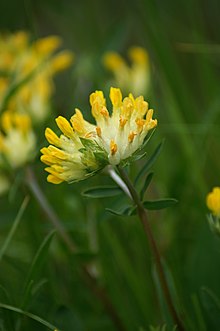| Anthyllis | |
|---|---|

| |
| Anthyllis vulneraria | |
| Scientific classification | |
| Kingdom: | Plantae |
| Clade: | Tracheophytes |
| Clade: | Angiosperms |
| Clade: | Eudicots |
| Clade: | Rosids |
| Order: | Fabales |
| Family: | Fabaceae |
| Subfamily: | Faboideae |
| Clade: | Robinioids |
| Tribe: | Loteae |
| Genus: | Anthyllis L. (1753) |
| Sections and species | |
|
See text | |
| Synonyms[1] | |
| |
Anthyllis is a genus of flowering plants in the family Fabaceae. This genus contains both herbaceous and shrubby species and is distributed in Europe, the Middle East and North Africa. The most widespread and familiar species is A. vulneraria (kidney vetch), a familiar grassland flower which has also been introduced to New Zealand.
Anthyllis species are used as food plants by the larvae of some Lepidoptera species including the following case-bearers of the genus Coleophora: C. acanthyllidis, C. protecta (both feed exclusively on A. tragacanthoides), C. hermanniella (feeds exclusively on A. hermanniae), C. vestalella (feeds exclusively on A. cytisoides) and C. vulnerariae (feeds exclusively on A. vulneraria).
- ^ "Anthyllis L." Plants of the World Online. Board of Trustees of the Royal Botanic Gardens, Kew. 2017. Retrieved 10 July 2020.